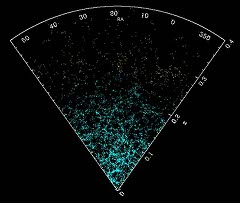Galaxy Clustering in a Slice of the SDSS: Notice that the distribution of galaxies is not uniform throughout space.
Credit: A. Pope (JHU) / Sloan Digital Sky Survey
It is always best to sell a project based on a single focused question and then do other things as opportunities arise. The big question that we settled on after many arguments was, How do galaxies cluster in the Universe? At the time, a lot of our colleagues thought we were wasting our time, not because we couldn't achieve our goals, but because the question had already been answered. What they meant was that it had been answered with 10,000 objects and we wanted to answer it with millions of objects. No one knew what we would find.
The reason clustering is so interesting is because all of the theories about the early Universe have it perfectly smooth, meaning that the density is the same everywhere in the Universe. In other words, nothing that we know of today, such as planets and stars, could have existed in the early Universe. And somehow or another every part of the Universe as it exists today still has all of the same properties: it has protons, neutrons, uranium, deuterium, all that kind of stuff. So there was some message sent throughout the Universe that you had to look this way. But one of the things that had obviously changed was that the smoothness had disappeared and today everything is clumpy in the form of human bodies, planets, stars, galaxies, etc.
Human bodies are much more dense than the atmosphere of Earth; the atmosphere is much more dense than space; and the space in the galaxies is much denser than the space between the galaxies, etc. How did that structure develop? That was the big question.
We knew that it was smooth in the early days and we could measure a little bit of the structure at a certain point a few hundred thousand years after the Big Bang using the cosmic microwave background, but then there was no data about later times except that there were hints from another survey done by Harvard University astronomers in the early 1980s. Neither of these were sufficient to answer the focus question we were after. We started by doing what we could do mainly by mapping the Universe in great detail in the present epoch. Another expected outcome of the survey was the mapping of the clumping of the Universe at many points back in time.


